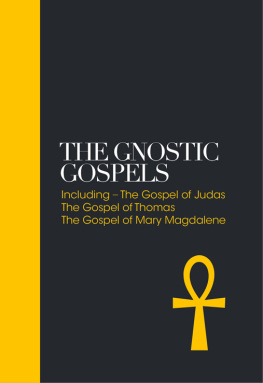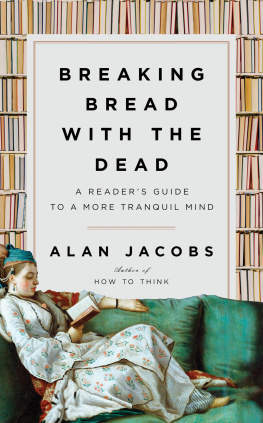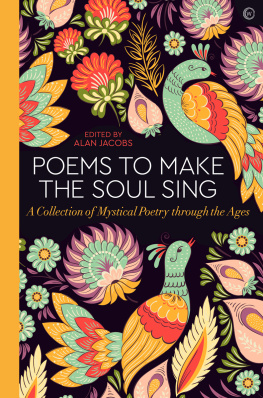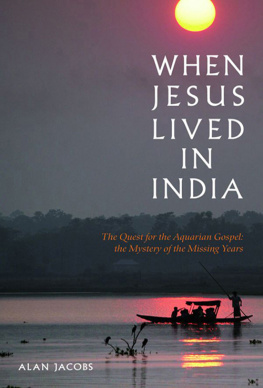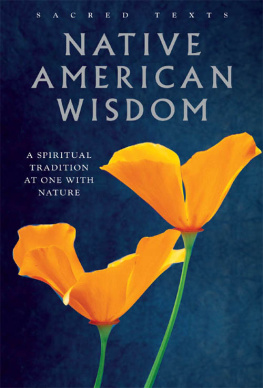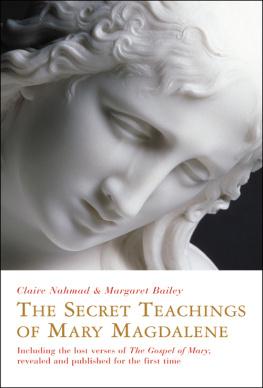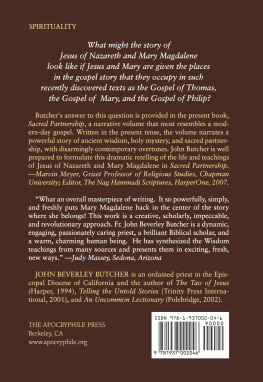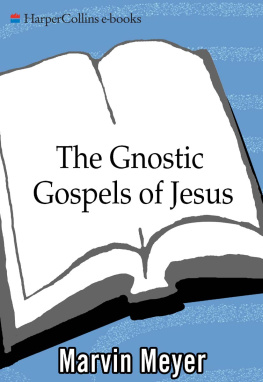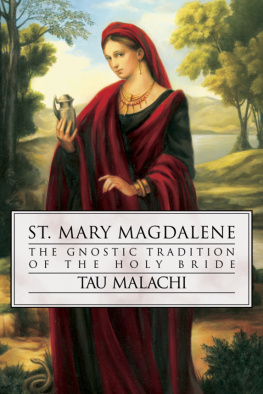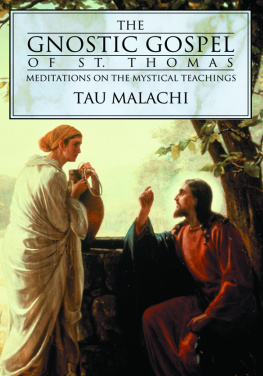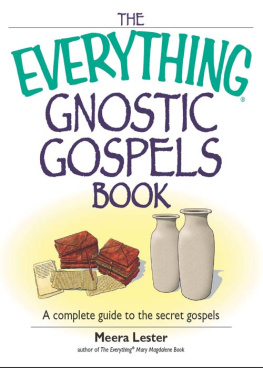SACRED WISDOM
THE
GNOSTIC
GOSPELS
Including
The Gospel of Judas
The Gospel of Mary Magdalene
The Gospel of Thomas
Alan Jacobs
Introduction by
Revd Dr Vrej N. Nersesssian

FOREWORD
As discovered at Nag Hammadi, the Gnostic Gospels, written mainly in Early Coptic, are severely fragmented and full of lacunas. My aim has been to provide a clear, readable text that preserves the essential meaning, hence obscurities and needless repetitions have been omitted from some tracts.
From the fifty-three texts discovered, I have chosen the fourteen reproduced here because I felt they were potentially of greater interest to the contemporary reader. In addition, unlike some of the remaining texts, they are not abounding in archaisms and strangely coined proper names whose derivation and usage have largely been lost.
The selected Gospels reveal sayings of Christ not included in the New Testament and throw light on the intimate relationship between Jesus and his disciples. The Gospel of Mary Magdalene, for example, gives details of his relationship with this favoured disciple. Other texts show the structure of Gnostic cosmology.
My poetic transcription is in free verse form, paraphrased from the widely differing literal prose translations in existence. I have relied on my own practical knowledge of the mystical path in the higher religious traditions to make as much sense as possible of these truly beautiful, ecstatic and awe-inspiring texts.
Alan Jacobs
BIOGRAPHIES
Alan Jacobs has made a lifelong study of mysticism and is a regularly published author and poet. He is the editor of Poetry for the Spirit, Tales from Rumi, Native American Wisdom and the beautiful poetic translations of The Upanisads also in this series.
The Reverend Doctor Vrej Nersessian is the curator of the Christian Middle East section at the British Library. He is a senior priest at the Armenian Apostolic Church, holds a doctorate in Theology from Kings College London and is a world authority on the Christian Middle East as well as an author of a number of significant works.
INTRODUCTION
J ewish beliefs marked Christianity permanently until the fourth century, when Jewish Christians who had been prominent in the New Testament were reduced to a remnant. Those who survived had their own Gospel according to the Hebrews. They denied the Virgin birth of Jesus, but others accepted it while denying that he had existed before his adoption by the Holy Spirit. These believers were called Ebionites, meaning poor. Eusebius believed that the term was appropriate because of their poor and low opinions of Christ. Origin, a prolific author of the early Church, quoted an Ebionite belief that Jesus had said he had been taken by my mother the Holy Spirit by one of the hairs of my head. Another poetic expression ridiculed by Christian literature was a version of the Trinity where the Son is described as the cup, the Father as he who was milked, and the Spirit as She who milked him. This comes from The Odes of Solomon, a collection of hymns found in 1905. One hymn says about Jesus:
His love for me brought low his greatness
He took my nature so that I might understand him,
My face so that I should not turn away from him.
The last among these hymns portrays Jesus as the Just One hanged by the roadside, moving from his cross to join the dead and saying:
They ran towards me, the dead
And I heard their voices and
wrote my name on their heads,
So they are free and they are mine,
Alleluia!
Christian teaching had become hostile to Judaism, as evidenced in the Letter of Barnabas, written in the second century. It was claimed that an evil spirit had inspired the Jews to misunderstand the purposes of God throughout their history. Ignatius, in the second century, did not hesitate to talk about Jesus as our God, whatever might be the objections of Jews. In his Letter to the Magnesians he wrote, God is one and has revealed himself to his Son Jesus Christ, who is his Word issuing from silence. But he said that the zeal of the Christians in Ephesus had been aroused by Gods blood and begged the Christians in Rome not to try to prevent his own martyrdom: Let me imitate the suffering of my God. He was not interested in offering any philosophical defence of such expressions, for the main thrust of his message was a plea for Christians to unite; he was less interested in finding common ground with Jews or with any others who did not share his faith. His lifes ambition was to become Gods wheat, and I am ground by the teeth of wild beasts so that I may become Christs pure loaf Come fire, cross, a battle with wild beasts, the wrenching of bones, the mangling of limbs, the crushing of my whole body, the cruel tortures of the Devil only let me get to Jesus Christ. He also said, my Love is crucified, meaning that his own human passions had died with Jesus. Paul had expressed a similar sentiment, but Ignatius went beyond the more balanced Paul by saying plainly that he was in love with death. The Armenian poet Gregory of Narek (9511003) likens his relationship to Christ to the wick in the candle:
You gave the oil, and in this oil you placed a wick
which exemplifies your union, without imperfection,
with our condition, formed and woven with
your love of mankind.
[Gregory of Narek, Book of Lamentations, Erevan, 1985]
Christianitys main partners in the fourth century were not Jews but pagans, or, more often, people who were seeking reality in religion and not finding it in either Judaism or paganism. The great question was, What did such seekers have to believe in order to be Christians? If Christianity was no longer a Jewish sect, how far could it go as it left its Palestinian birthplace? Could it go on to speak about mysteries hitherto left to what Ignatius had called the silence?
Answers were given by a number of movements lumped together under the name Gnostics, derived from the Greek word gnosis, first mentioned in 1 Timothy 6.20. This name was used to cover groups of people who were not content with the statements of faith and modes of behaviour that had been handed down and widely accepted. The principal characteristic of Gnosticism in its many shapes and forms was a negative evaluation of the material world and, therefore, of its Creator. Dualistic language about spirit and matter, usually cast in mythological form, was common, and the distinctiveness of different sects often lay in the imaginative myths by which individual teachers expressed their dualism. They speculated about the origins of the cosmos and how the human soul came to be imprisoned in a body of flesh. The theme from The Gospel of St John that the divine Logos had united human flesh to himself was difficult to grasp for anyone who thought the flesh vile. It seemed altogether easier to think of the divine Logos being united to the human soul and not to the human body.
At the time when Gnostic movements were shaping their mythologies there was no fixed canon of the New Testament writings, and Gnostic teachers were proud to be able to produce Secret Saying of Jesus, accounts of what Jesus had said to his disciples between the Resurrection and the Ascension. The Gospels, Acts, Letters and Apocalypses widely current were not limited to those which in the course of time became the New Testament. There were also Gnostic texts which the Church did not recognise as authoritative and which were excluded from the canon.
In 1945, in a village in Upper Egypt called Nag Hammadi, a camel driver uncovered a jar containing the remains of thirteen codices. Analysis of the materials used in the bindings of the codices shows that they had been produced in the area in which they were found. Dates on letters and grain receipts indicate a date in the mid fourth century AD. References to the Coptic monk Pachom were proof that the volumes had been in the possession of the Pachomian monks who inhabited the area.
Next page
